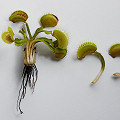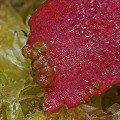Q: How do I vegetatively propagate my Venus flytrap?

Leaf pullings

Plant nubs (at left)
A: Vegetative propagation has a few advantages. First, it is easy. Second, it produces large plants
rapidly---you can turn a single large plant into several large plants within a year or two. Third, if you have a special clone (perhaps
with unique floral or leaf characteristics), vegetative propagation will result in genetically identical offspring.
There are several vegetative propagation methods. Below are the two easiest.
1)As Venus flytraps grow, they occasionally form a second rosette of leaves. You can tell this is
happening because the rosette starts to become crowded, and leaves are obviously emerging from more than one
point. Your automatic impulse may be to separate the second rosette from the main
rosette. Resist this impulse and
wait a few years. If you do it too soon, you will have to rip the plants apart
and risk the lives of both plants to infection. Give them
plenty of time to form separate root systems.
2)You can take "leaf pullings" of your plants. This should only be tried if
your plants are doing very well. The traps should be big and sturdy. If you
try leaf pullings with a sickly plant, you may kill it.
To prepare a leaf pulling, dig the plant out of the ground to expose the white enlarged
base. Pull a healthy leaf down and away from the plant so the entire leaf (green top and white base)
is pulled away. This is absolutely not a leaf cutting--your scissors or knives
should be nowhere in sight for this.
It is crucial that you remove as much of the leaf base as possible, including plenty of the
pale beige or white tissue near the leaf base. Some people recommend using only the short, wide winter
leaves for leaf pullings, but I have not found this to be important.
(Incidentally, with no false modesty I note that I believe
"leaf pulling" is a term of my own coinage. I certainly didn't invent the technique, just the name.
That, a few cultivars, and the
term "Slack-potting" are my contributions to carnivorous plant
horticulture. Aahh, what a minor life I lead.)
Lay your leaf pullings on the soil surface, and partly bury them with strands of
sphagnum moss or potting material. Keep the light levels very high and the
pullings warm. Storing their pots in baggies might be a good idea.
Look for plantlets after a few months--they'll start off as little nubs
of growth.
Page citations: Personal observation.